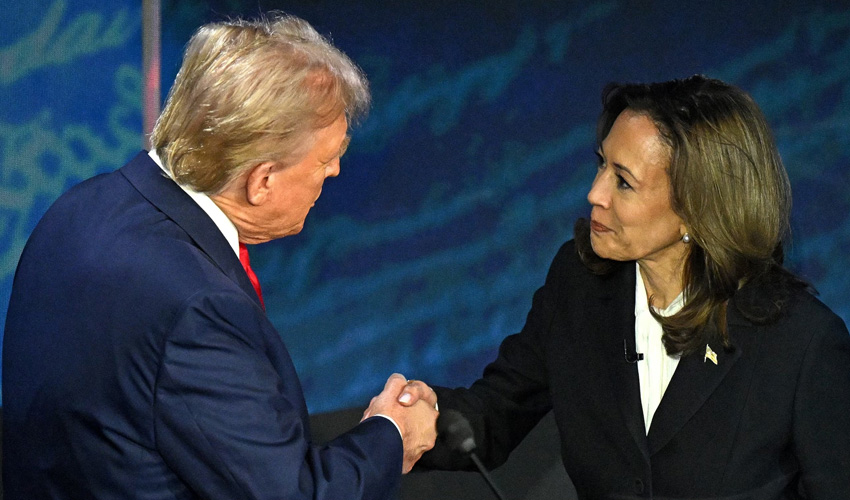As the US presidential election looms on November 5th, the race between Vice President Kamala Harris and former President Donald Trump has reached a critical juncture. The election dynamics took a dramatic turn in July when President Joe Biden withdrew from the race, endorsing Harris as the Democratic nominee. This change has set the stage for a highly anticipated showdown between Harris and Trump, with implications for the future of American politics.
On September 10th, over 67 million viewers tuned in for the highly anticipated debate between Kamala Harris and Donald Trump, held in Pennsylvania. The debate was a crucial moment for both candidates to sway undecided voters and solidify their positions. According to a Reuters/Ipsos poll of 1,400 registered voters who were at least somewhat familiar with the debate, 53% believed Harris emerged victorious, while 24% felt Trump won. This poll also showed Harris leading Trump nationally by five points—47% to 42%—a slight increase from her 45% to 41% lead in August.
Similarly, a YouGov poll of 1,400 U.S. adults who had watched the debate found that 55% thought Harris performed better compared to 25% for Trump. However, this poll revealed no change in voter intentions, with Harris maintaining a slim lead of 46% to 45% over Trump.
The Morning Consult poll, which surveyed 3,300 likely voters, indicated that Harris led Trump by 50% to 45%. Although Trump’s support had dipped by one percentage point from the pre-debate poll, this shift did not significantly impact the overall lead Harris held.
Debate performance on election prospects
While the debate results suggest that a majority of viewers felt Harris was the stronger performer, the effect on voter intentions appears minimal. Many Americans have already made up their minds, and the debate performance might not drastically alter their decisions. This highlights the challenge in shifting voter sentiment in such a polarized environment.
National polling trends
Before Joe Biden’s withdrawal, national polls consistently showed him trailing Trump, with some suggesting that Kamala Harris might not fare much better. However, since Harris hit the campaign trail, she has developed a small but consistent lead over Trump in national polling averages.
Recent polling data, averaged from various sources, shows Harris with a modest lead. Yet, it's essential to note that national polls provide a broad view of candidate popularity but do not predict the election outcome due to the U.S. electoral college system. To win, a candidate needs to secure 270 out of 538 electoral college votes, which makes battleground states crucial in determining the election result.
The battle in the battleground states remains extremely tight. Recent polls indicate that Harris and Trump are separated by less than one percentage point in several key states, including Pennsylvania, Michigan, and Wisconsin. These states are critical as they hold a significant number of electoral votes.
Pennsylvania, in particular, has seen a shift in dynamics since Harris became the Democratic nominee. When Biden exited the race, he was trailing Trump by nearly five percentage points in these pivotal battleground states. The current narrow margins suggest that the race remains highly competitive and could go either way.
Poll averages and their reliability
Polling averages, such as those provided by 538, offer insights into overall trends by combining results from various polls. 538 collects data from reputable polling companies, ensuring transparency and methodological rigor. However, it's crucial to recognize that polls are not always accurate predictors of election outcomes. Historical data shows that polls underestimated Trump’s support in both 2016 and 2020.
Pollsters are working to address these issues by refining their methodologies to better reflect voter demographics and behavior. Nonetheless, with the election approaching, predicting the exact outcome remains challenging due to factors such as voter turnout and late-breaking developments.
As Election Day draws nearer, the race between Kamala Harris and Donald Trump remains highly competitive. The debate performances have provided valuable insights, but the overall impact on voter preferences appears limited. With national polls showing a narrow lead for Harris and battleground states still too close to call, the election outcome hinges on key factors such as voter turnout and shifts in undecided voters.
The upcoming weeks will be crucial as both candidates intensify their campaigns to sway voters and secure critical electoral votes. For now, the polls offer a snapshot of the current state of the race but will need to be watched closely for any significant changes as the election approaches.
In this high-stakes election, the performance in debates, the effectiveness of campaign strategies, and the ability to connect with voters will play pivotal roles in determining the next President of the United States.



























